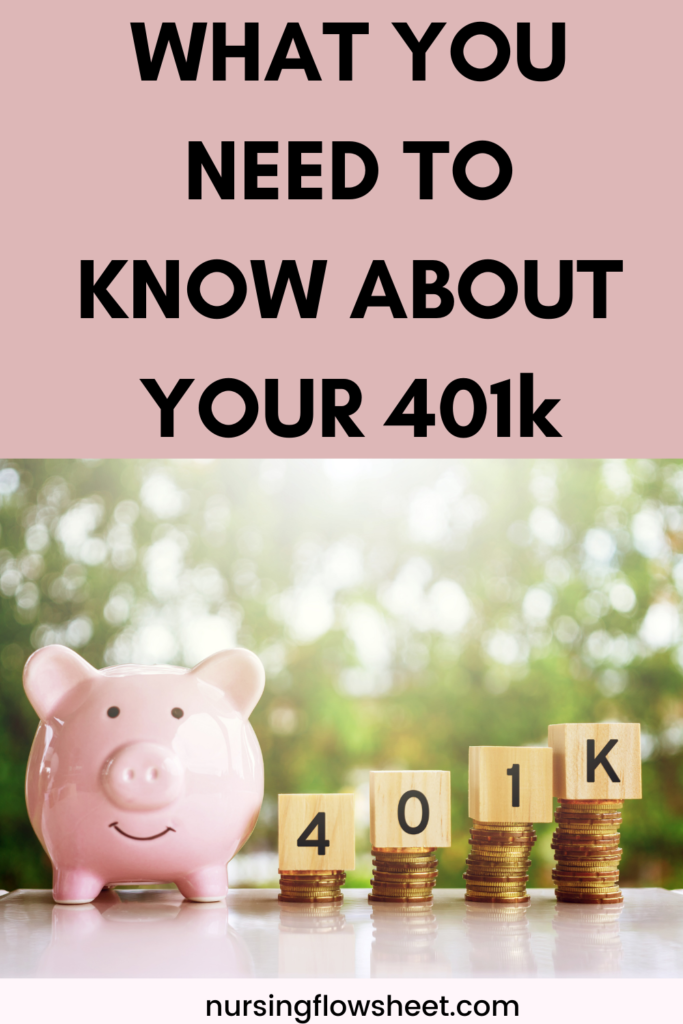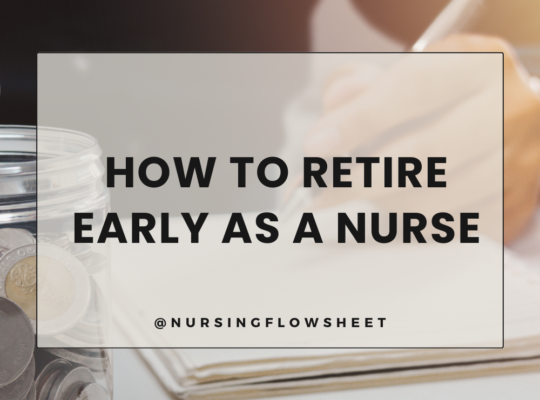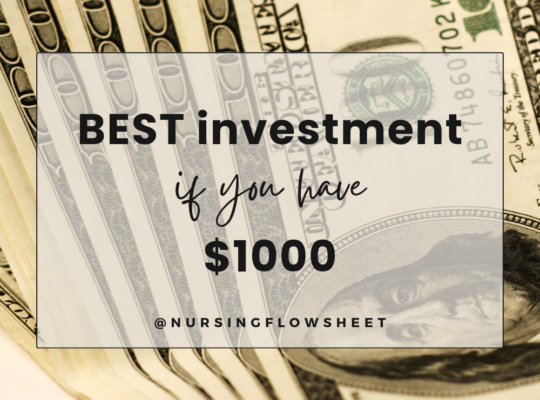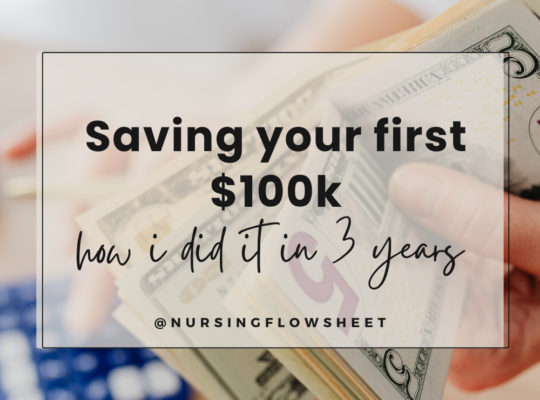401k plans or employee-sponsored retirement accounts are one of the best and easiest ways to save for retirement, but many Americans aren’t making the most of them and some aren’t participating at all. Only 32% of Americans are investing in a 401k, according to the U.S. Census Bureau.
(updated 2024)
Most people who have access to an employer-sponsored retirement savings plan know that they are supposed to participate, but it can be hard to get started. Most people including myself (when I was a new grad nurse) find it overwhelming to learn about what it is and what options I have.
There are stories of losing money or not even able to access their accounts when they get older.
So, what is a 401k? How can I invest in one and how much do I need to invest? Can I take it out before retirement?

What is a 401k Retirement Account?
A 401k is a retirement plan offered through an employer.
These are some of the most common retirement plans offered to employees. You can also have 403(b) or 457(b) which is essentially the same thing but have different rules.
History of 401K Retirement Account
In 1978, Congress passed Revenue Act which includes a provision that allows employees to avoid being taxed on a portion of income they decide to receive as deferred compensation, rather than direct pay. The provision becomes Internal Revenue Code Sec. 401(k)
It was intended to allow taxpayers a break on taxes on deferred income until an attorney in 1980 named Ted Benna took note of the previously obscure provision and figured out it could be used to create a simple, tax-advantaged way to save for retirement. The rest, as they say, is all employee benefits growth.
When it was first offered, the maximum contribution limit was $45,575 for employees and a total of $91,150 for both employee and employer contributions which is pretty crazy! It has slowly decreased since then.
In 2006, The Pension Protection Act made it easier for companies to enroll their employees automatically in 401(k) plans and offer target-date funds as a default option.
Nowadays, some employers offer a 401k match and in 2022, they have increased the maximum contributions from $19,500 to $20,500.
Why use the 401K?
While I made the mistake of taking my 401k out when I left my first nursing job, I love them for two main reasons: TAX ADVANTAGE + FREE MONEY.
- 401(k)s help you reduce your tax bill. Every dollar you invest in your 401(k) is a dollar that you don’t have to pay taxes on. That’s amazing if you may ask me! If you’re in a high tax bracket, then contributing to your 401k can save you thousands of dollars in taxes. Use this 401k calculator if you want to know how much you’ll save and have for retirement.
- Your employer is giving you free money. In many cases, your employer will match part of your contribution. Free money! If you aren’t contributing at least UP TO YOUR EMPLOYER MATCH, you are turning away FREE MONEY!
What is Employee matching?
- It means that your employer contributes a certain amount to your retirement savings plan based on the amount of your annual contribution. It could be partial match (50%) or full match (100%)
- For example: If you make $60,000 annually and your your employer says it will match dollar for dollar (100%) up to 3% of your salary. What it means is that if you put in $1800/year (3%) in your retirement account, your employer will add $1800 as well giving you a total of $3600 annual contribution and that my friend, is FREE MONEY
How much does a person have in their 401k?
The average 401(k) balance by age
Take a look at this chart showing the estimated average 401(k) balance by age. (Empower)
| Age | Average 401(k) | Median 401(k) |
| 20s | $74,460 | $29,753 |
| 30s | $160,517 | $69,718 |
| 40s | $344,182 | $151,274 |
| 50s | $558,740 | $247,338 |
| 60s | $555,621 | $209,382 |
| 70s | $417,379 | $103,219 |
| 80s | $385,783 | $78,534 |
Anonymized data from Empower Personal DashboardTM as of January 2024.
That’s pretty low if you ask me, and there could be a lot of reasons why that’s the case (not maxing out contributions, expensive living expenses, global pandemic, personal hardships etc)
This is also another reason why you should never rely on just your 401K for retirement. There are definitely way more investment accounts to help you live comfortably when you retire.
READ: How you can use your Health Savings Account for Retirement
So, why contribute to a 401k?
Retirement is NOT what it used to be. The era of pension is over. Ask your parents or grandparents about pensions. Back then, it was the employer’s responsibility to give their employees a nice, comfortable retirement. Now, IT’S ON US. For most, there will be no safe and steady income stream after you slaved away for 40 years working.
Also, there has been speculations and news that the Social Security will be depleted by 2035. Well, that’s less than 15 years from now and if you are like me, who’s younger (AHEM), we will NOT SEE THAT FUNDS when we retire.
So you’re probably asking now, should I be maxing out my contribution then?
Let’s talk about how much you should be putting on your 401K.
How much should you have in your 401k?
In my opinion, every one has different financial situations they are in and you should focus on paying off high interest debts, starting an emergency fund etc, but in general, you should be maxing out on your contributions for your 401k and if you can’t, at least put money into it to get your full employer match.
The contribution limit for employees who participate in 401(k), 403(b), and most 457 plans, as well as the federal government’s Thrift Savings Plan is increased to $23,000, up from $22,500. Any employer matchign is done on top of the limit. The limit on annual contributions to an IRA increased to $7,000, up from $6,500.
Keep in mind that your retirement plan should always focus on leveraging tax deferment and a high savings.
Your 401k is YOUR MONEY
If ever you leave a job, know that the money in your 401k is yours. You can either roll it over to another IRA or to your new employer 401k account. If your account is over $5000, you can leave it at your old employer’s 401k account and just let it grow there but I would prefer rolling it over so you have access and control of your investments.
You can also withdraw your 401k money through a 401k Loan or early withdrawal (which will be a pretty hefty price to pay when it comes to taxes and fees). I KNOW, I MADE THIS MONEY MISTAKE MANY YEARS AGO! Yikes.
READ: MONEY MISTAKES YOU SHOULD BE AVOIDING
The rule for 401k withdrawal is after 59 ½ years old and if you decide to withdraw your money from your 401k BEFORE 59 ½ , that would be considered early withdrawal and subject to:
- 20% federal taxes
- 10% withdrawal penalty fee to the IRS
- you will miss out on potential growth.
So, just a little advice ~ Don’t take it out early! Or if you do, read up on ROTH CONVERSION LADDER & how you can use your 401k money for early retirement.
In conclusion,
401k or employee sponsored retirement account is a good way to invest for your future while giving you great tax benefits. Some employers offer a match and as a rule, you should be contributing at least up to this match for free money. Your 401k money is YOUR MONEY and you can take it with you whenever you leave your job. Good luck! Happy investing!







